Should I Prewash My Quilting Fabric? Quick Tips and Insights
Deciding whether or not to prewash fabric for quilting can be a challenging choice for many quilters. Some highly recommend prewashing, while others prefer to work with the fabric as it comes off the bolt in the quilt shop.
This article is designed to provide you with an understanding of the pros and cons of prewashing fabrics to help you determine the best course of action for your quilting projects.
Prewashing fabric serves several purposes: it can prevent dye bleeding, eliminate excess starch, and control shrinkage. This process will help ensure your quilts maintain their appearance and structural integrity in the long run. However, certain fabrics, such as precut squares and strips, should never be prewashed due to the risk of fraying and distortion.
We will explore the benefits and drawbacks of prewashing quilting fabrics, as well as tips and techniques for effective prewashing. You’ll then have the knowledge you need to decide the best approach for your quilt washing needs.
Pros of Prewashing Fabric
Prevent Shrinkage
One of the key benefits of prewashing your fabric for quilting is to prevent shrinkage. Different fabrics can shrink at different rates, and this can lead to an uneven or puckered appearance in your finished quilt.
By prewashing your fabric, you can remove some of the shrinkage, giving you a smoother and flatter finished quilt. Plus, it “equalizes” the various fabrics you may be using, such as cottons, woven plaids, or batiks.
Prevent Dye Bleeding in Your Finished Quilt
Another advantage of prewashing your fabric is to prevent dyes from bleeding onto other areas of your quilt. Some bright colors like reds and purples can run and bleed when washed. This can be quite devastating when it happens to a finished quilt. When you prewash your fabric, you can identify any fabrics that may bleed excessively and take necessary precautions, such as using color catchers or selecting alternative fabrics.
If I am particularly skeptical about a fabric, I will cut small pieces from the suspicious yardage and a white fabric, sew them together and wash them. Then I’ll check to see if there is any bleeding after washing, drying and ironing.
I’m sensitive to fabric bleeding because I had a particularly bad experience when working on a very large heirloom applique project and the reds started bleeding. Note, the red in the image below WAS prewashed. The block was soaked in a bowl of water just to rinse out the markings.
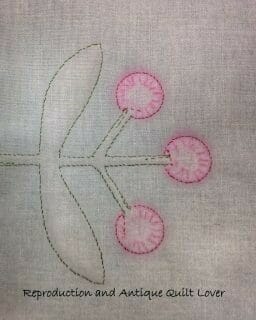
For more about this color bleed and how I managed to fix the problem, see the section on Color Catchers below.
Remove Sizing and Chemicals
Prewashing your fabric can help remove sizing (a stiffening agent added by manufacturers) and chemicals that are often present on new fabric. Sizing is a type of starch that’s applied to the fabric during manufacturing to give it a smooth finish and make it easier to handle.
However, some quilters find that leaving sizing on the fabric makes it harder for them to work with or affects the overall feel and appearance of their finished quilt. For example, I find it harder to get pieces to lay flat when the fabric isn’t prewashed. The edge pieces seem to want to pop up.
Textiles may have a lot of chemicals acquired through the growing and manufacturing of cotton yardage like formaldehyde, pesticides and heavy metals. Personally, I have found my skin to be very sensitive to drying, cracking and getting a rash when I handle a lot of unwashed fabric.
By prewashing your fabric, you can remove any sizing and other chemicals, giving you a more natural and comfortable material to work with for your quilting project.
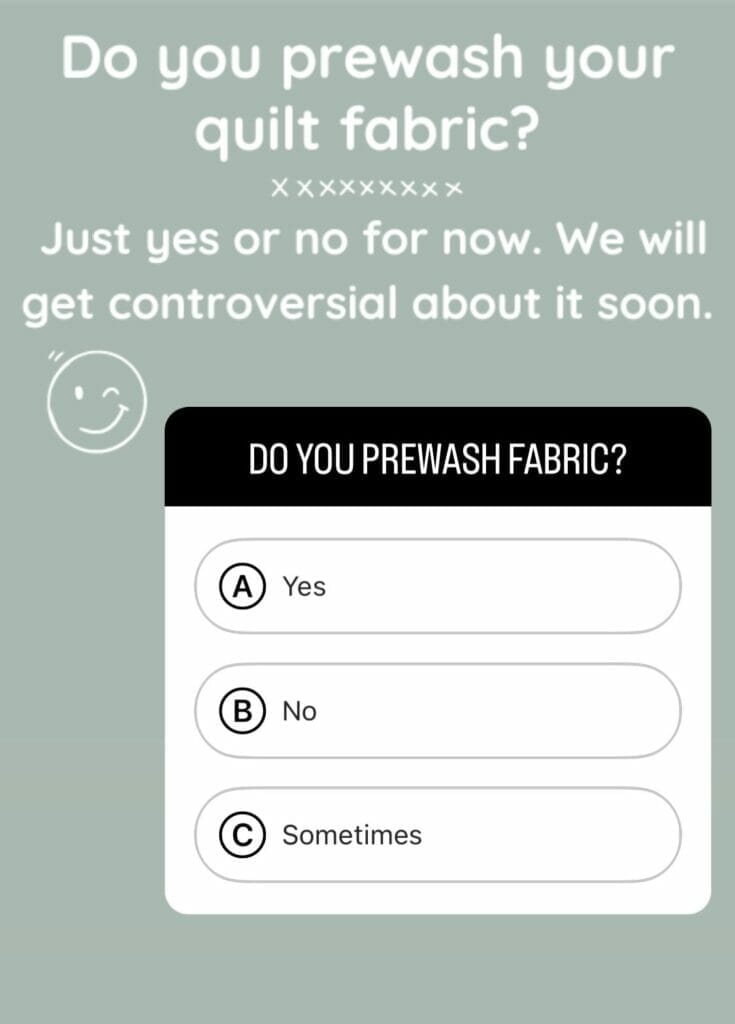
Cons of Prewashing Fabric
Difficult to Work with Precuts
When you prewash your fabric for quilting, it can make working with precuts more challenging. Precuts are pre-cut pieces of fabric that come in various shapes and sizes and speed up the quilt construction part of a project. There is less cutting needed.
Precuts are also a great way to get a big variety of prints and colors without purchasing a lot of fabric you don’t need. Because they have already been cut, washing them can lead to fraying and distortion. making it harder to maintain their original shape and size. The result is waste and a process that is more tedious and time-consuming.
Reduced Crispness for Piecing
Unwashed fabric typically has a crisp feel to it. This crispness can make it easier for you to piece your quilt. Because it holds its shape better, your seams and points line up more accurately. However, when you prewash fabric, it removes the sizing (discussed in the pro-washing section above) and tends to soften the fabric.
So, although your quilt may feel softer overall, it may be slightly more challenging to achieve a clean and precise look when piecing.
Shrinkage May Give You the Vintage Look You Want
Quilters often was their machine quilted reproduction quilts to have a nice “crinkled” appearance after quilting and washing. This is best achieved by making your quilt from unwashed fabric. Once quilted (all over stippling is an excellent choice for this look) wash and dry the quilt in your home machine. It will come out soft and looking like a vintage quilt. The effect isn’t as pronounced when the quilt is made from prewashed fabric.
Fading of Vibrant Dyes
If your quilting project includes fabrics with vibrant dyes, prewashing can cause some of the colors to fade, especially if the fabric is not colorfast. It’s true that prewashing helps prevent color bleeding and running in a finished quilt.
But, the trade-off is a potential reduction in the intensity and vibrancy of the fabric’s original colors. If maintaining the highest level of brightness in your quilt’s palette is important to you, you might consider skipping the prewashing step.
Ultimately, the decision to prewash your fabric is a matter of personal preference. Carefully weight the pros and cons before committing to prewashing. The decision depends on the specific fabrics and project you’re working on and the goals you have for the finished quilt.
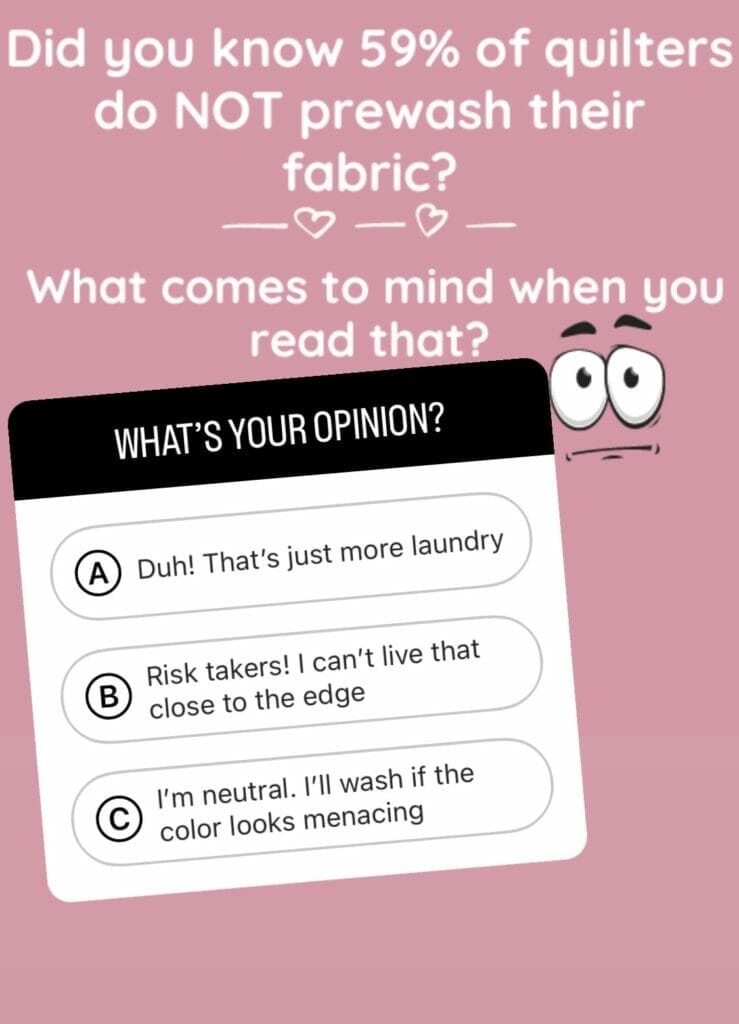
How to Prewash Fabric for Quilting
Fabric Prewashing Techniques
All of my quilts are made from 100% cotton fabric and that is the fiber I know well. I did take a class on textile chemistry when I was in college so I know there are many different fibers and weaves available. But, I won’t be addressing them in this article.
Cotton fabrics can shrink 3% or more when washed. Prewashing cotton helps prevent uneven shrinkage in your finished quilt. When prewashing cotton fabrics, use cold water and a gentle cycle. You can prewash cotton at home using your regular washer and dryer.
To help reduce fraying, nip a very small triangle of fabric off of each corner of your fabric before washing.
Using Color Catchers
Remember that bleeding red mentioned above? Because of that, I’m going to go into some detail about color catchers.
Shout Color Catchers are sheets about the size of a dryer sheet that you put in the wash with your fabric or clothes. The manufacturer claims the Shout Color Catcher absorbs colors that run so you no longer have to separate ‘whites’ from colors when you do the laundry. See report by CBS News here.
I’ve never used them in my laundry but I have with my quilting fabric. When I do, the white sheet definitely comes out a different color. I usually use it with reds so the sheet is a nice bright pink color and the rest of the laundry is the color it is supposed to be.
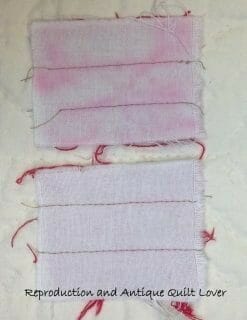
The image above is a piece of one of the reds that was bleeding in the applique I showed previously. As a test to see if it would bleed, I stitched a piece of the red to my background fabric. Then I added a color catcher to the wash load. The sample at the top is what happened. Ack!!
This was the first wash of the fabric. So, I gave the fabric a second chance and stitched a pieced of the now prewashed red to the back ground fabric and washed it again with a color catcher. The bottom sample is the result. Better, much better.
Nothing is foolproof. If you make a quilt from a suspect fabric, you might want to include a Color Catcher every time you wash the quilt.
Drying and Pressing Tips
After washing, dry your fabrics on a low heat setting or lay them flat to dry. This will help maintain their size and shape, as well as prevent excessive shrinking.
Some muslins can be extremely wrinkly after washing. For those, I take them out of the dryer and press them while they are damp. That results is very flat and crisp fabric that is a pleasure to cut and sew.
Other fabrics can be dried completely and then pressed. Ironing your fabric will remove any creases or folds, making it easier to work with for quilting.
Remember, prewashing your quilting fabric can help prevent shrinkage, color bleeding, and other issues that may affect your final quilt. By following these steps, you’ll ensure that your fabric is clean, uniform, and ready for your quilting project.
I do not recommend washing long narrow cuts of fabric like a 1/4 or 1/8 yard by the width of the fabric. They twist a lot in the wash and get very wrinkly and the wrinkles are hard to remove. If you do wash those cuts, be sure to press them when damp.
Special Considerations for Precuts
Quilting with precuts offers an easy and fun way to create unique designs. But, prewashing them requires special attention to avoid distortion and maintain their integrity. In this section, we will focus on prewashing charm packs, jelly rolls, layer cakes, and fat quarters.
Charm Packs, Jelly Rolls, Layer Cakes and Fat Quarters
Charm packs and jelly rolls can be tricky to prewash due to their small size. To successfully clean them without risking damage, follow these steps:
- Fill a basin or sink with cool water: Immerse a single color group (light or dark) of your fabric in the water, preventing dye transfer between different shades.
- Gently agitate: Carefully swish the fabric around, avoiding excessive twisting or wringing that could cause distortion.
- Rinse thoroughly: Ensure all soap is removed by rinsing the fabric with clean water.
- Dry cautiously: Skip the dryer; rather, lay the fabric strips or squares on a flat surface to air dry.
Remember that prewashing charm packs and jelly rolls can help prevent shrinking and dye bleeding in the final quilt. You can decide if the risk is worth the extra work.
I have no problems washing layer cakes and fat quarters. Pieces of fabric of that size and are more square than long and skinny come out fine when put in the washer and dryer.
Conclusion
In conclusion, the whole prewashing debate can get pretty heated among us passionate quilters. But hey, let’s take a deep breath and remember that we’re all here to create beautiful quilts in our own unique way.
After diving into the pros and cons of prewashing new cotton fabric, it’s clear that there are valid arguments on both sides. It really comes down to your personal quilting style, what you want your finished quilt to look like, and, perhaps, how much you trust a color catcher.
Do you love that vintage vibe and want your fabric to have a perfectly crinkled and aged look? Or maybe you’re all about those vibrant colors that stay crisp. These are some of the factors should guide your decision-making process.
We’ve shared some insights on what might happen if you choose to prewash or skip it altogether. Armed with this info, it’s time for you to make an informed choice based on what floats your quilting boat!
Remember, there’s no one-size-fits-all answer here. Quilting is all about expressing yourself and creating something uniquely yours. So go ahead, use this blog post as a helpful guide but trust your gut when deciding whether or not to give those fabrics a bath beforehand.
Happy quilting – may every stitch bring joy!
Can’t stop reading about quilts? Check out our series on scrap quilting!
- What is a Scrap Quilt? How to Show off Your Unique Style
- Ten Tips for Making a Scrappy Quilt
- Ten Top tips to Organize Your Fabric for Scrap Quilting
Leave a comment if you have suggestions about additional posts you’d like to see!
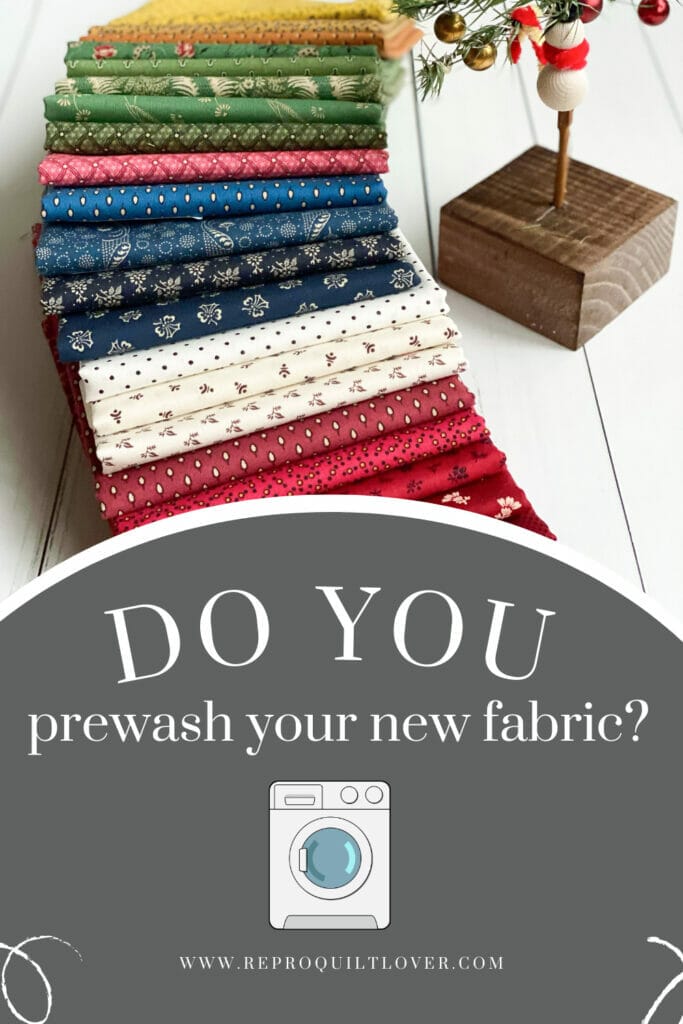
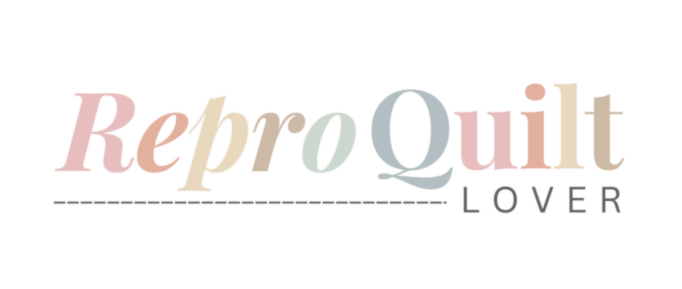
I prewash all fabrics for my quilts and am particularly cognizant of reds, purples and dark blues. I’ve also had green, cheddar and double pinks bleed, but not as bad. I usually use at least two color catchers and give some of them to a friend for her collage work. My “research” shows me that all lines of fabric I’ve used (quilt shop purchases) can, and will likely bleed. The fabric catchers are saved with a clip of the fabric and SKU info documented. If I want a bit of crispness back, I spray them with sizing. Since we do not know the life of our quilts beyond us, it is not worth it to me to not prewash.
I always prewash my fabrics. I’m a hand quilter and don’t want to quilt through the stiffer unwashed fabric. I’ve had things bleed even with pre-washing. You can never be complacent about red or dark fabric.
Hear! Hear! You saw my demo pictures, right? Mine bled after prewashing.
I prewash because I’ve always done it. Can’t change now after nearly 60 years! LOL
I know that feeling. But, there was likely a good reason you started prewashing in the first place.
I always prewash reds and blues. I just wanted to say your applique stitches are beautiful.
I find reds to be the worst but have had problems with all dark fabrics. Thanks for your nice compliment about the applique stitches. Applique takes a lot of practice and when I was working on that quilt I was doing a whole lot of it. Since then, the stitches are a lot more wobbly. 🙂